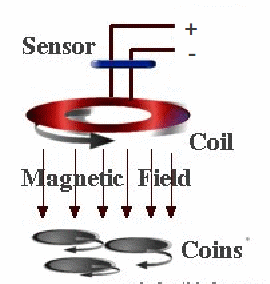Metal detectors work by detecting changes in the magnetic field as metal objects pass near them. A battery in the metal detector passes electricity down through the handle to the transmitter coil that is passed over the ground.

When electricity flows through the transmitter coil, it creates a magnetic field. When the coil is moved, the magnetic field moves with it. If there is no metal present, the magnetic field will be constant relative to the coil but if you sweep the detector above a metal objects, the magnetic field will induce an electric current to flow inside the object. This flowing electric current creates another magnetic field around the object. This magnetic field will act against the magnetic field of the coil according to Lenz's Law so the magnetic field in the coil will be disturbed. This disturbance can be detected and made to sound an alarm.
Simple hand held metal detectors operate in the same way. More sophisticated detectors used in airports may use the mutual inductance between two coils. If a person walks through two current carrying coils with metal on his person, he will change the mutual inductance![]() between the coils, where
between the coils, where![]() and
and![]() are the numbers of turns on the coils,
are the numbers of turns on the coils,![]() is the magnetic permeability of air,
is the magnetic permeability of air,![]() is the area of the second coil and
is the area of the second coil and![]() is the radius of the (circular) first coil. The magnetic permeability of the human body,
is the radius of the (circular) first coil. The magnetic permeability of the human body,![]() is about the same as the magnetic permeability of air, so
is about the same as the magnetic permeability of air, so![]() but the magnetic permeability of metal is much higher. Any metal passing through the first coil will change the mutual inductance between the coils and the induced EMF and an alarm can be activated.
but the magnetic permeability of metal is much higher. Any metal passing through the first coil will change the mutual inductance between the coils and the induced EMF and an alarm can be activated.
